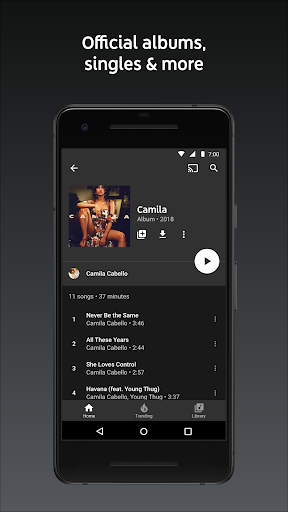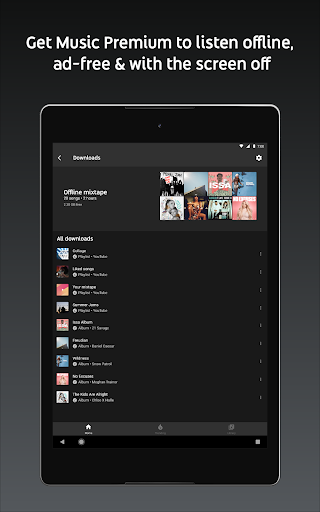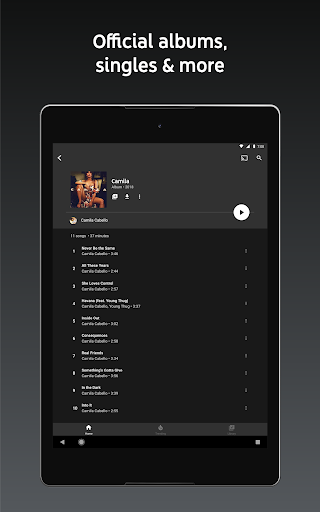| Rating: 4.3 | Downloads: 100,000,000+ |
| Category: Music & Audio | Offer by: Google LLC |
| Google Play Music App: Elevate Your Music Experience | music | streaming | google |
Google Play Music was a popular music streaming app developed by Google that provided users with access to a vast library of music and a range of features for an immersive listening experience. It allowed users to discover new music, create personalized playlists, and enjoy their favorite songs on various devices. Google Play Music seamlessly integrated with the user’s Google account, making it convenient for Android users to access their music across multiple platforms. However, as of December 2020, Google Play Music has been discontinued and replaced by YouTube Music, another music streaming service offered by Google.
Features & Benefits
- Extensive Music Library:Google Play Music boasted a vast collection of songs from various genres, including popular hits, classics, and indie music. Users could explore and discover music from their favorite artists and genres or delve into new and emerging artists. The comprehensive music library ensured that users had access to a wide range of songs to suit their preferences.
- Personalized Recommendations:The app provided personalized recommendations based on the user’s listening history, liked songs, and preferences. It analyzed the user’s music taste and suggested similar artists, albums, and playlists tailored to their interests. This personalized approach helped users discover new music while ensuring they had a customized listening experience.
- Music Upload and Cloud Storage:One standout feature of Google Play Music was the ability to upload and store personal music collections in the cloud. Users could upload up to 50,000 songs from their personal libraries and access them on any device with the app installed. This feature allowed users to have their entire music collection available at their fingertips without taking up storage space on their devices.
- Ad-Free Listening with Subscription:Google Play Music offered a subscription service called “Google Play Music All Access” that provided an ad-free listening experience. Subscribers could enjoy uninterrupted music playback and access additional features such as offline listening, creating custom radio stations, and on-demand playback of any song from the app’s library.
- Cross-Platform Compatibility:Google Play Music seamlessly integrated with various platforms and devices, making it convenient for users. It was available on Android and iOS devices, as well as web browsers. Users could start listening to music on one device and seamlessly transition to another, with their playlists and preferences synced across platforms.
Pros
- Music Library and Discovery:Google Play Music’s extensive music library and personalized recommendations allowed users to explore and discover new music tailored to their tastes. It provided a vast collection of songs from different genres, ensuring that users had access to a diverse range of music.
- Cloud Storage and Personal Music Upload:The ability to upload personal music collections to the cloud and access them on any device was a significant advantage. Users could enjoy their own music library alongside the app’s streaming catalog, providing a comprehensive music experience.
- Cross-Platform Compatibility:Google Play Music’s compatibility with multiple platforms and devices allowed users to seamlessly transition between devices without losing their listening history, playlists, and preferences. This flexibility made it convenient for users who used different devices throughout the day.
- Ad-Free Listening and Additional Features:The subscription service offered an ad-free listening experience and provided additional features such as offline listening, on-demand playback, and custom radio stations. These features enhanced the overall music streaming experience and catered to users’ preferences and convenience.
Cons
- Discontinued Service:One significant drawback of Google Play Music is that it has been discontinued and replaced by YouTube Music. Users who were heavily invested in Google Play Music had to transition to the new platform, which might have caused inconvenience and required adjusting to a different user interface and feature set.
- Limited Social Interaction:Compared to some other music streaming platforms, Google Play Music had limited social interaction features. It did not emphasize social sharing, following friends, or collaborative playlist creation within the app itself, which may have been a downside for users who enjoyed a more social music experience.
- Regional Availability:Google Play Music’s availability varied by region, and some features were limited to specific countries. Users in regions with limited availability may not have had access to the full range of features and content, which could be a disadvantage for international users.
Similar Apps
Spotify: Spotify is a leading music streaming app that offers a vast library of songs, personalized playlists, and algorithmic recommendations. It provides both a free ad-supported version and premium subscription options.
Apple Music: Apple Music provides a comprehensive music streaming experience, offering a vast catalog of songs, personalized recommendations, and curated playlists. It is available for iOS and Android devices.
Amazon Music: Amazon Music offers a diverse collection of songs, personalized recommendations, and curated playlists. It is available for Amazon Prime members, with a vast selection of music at no additional cost4.?Pandora: Pandora is known for its personalized radio stations that are curated based on user preferences. It offers a unique listening experience, allowing users to discover new music tailored to their taste.
Tidal: Tidal is a high-fidelity music streaming service that focuses on delivering superior audio quality. It offers a vast library of songs, including exclusive content from popular artists.
Deezer: Deezer provides access to a large music catalog, personalized recommendations, and curated playlists. It also offers a feature called “Flow,” which creates a continuous stream of music based on the user’s listening history.
Screenshots
 |
 |
 |
 |
In conclusion, the Google Play Music app is a versatile and feature-rich platform that offers a vast music library, personalized recommendations, ad-free listening, offline playback, and seamless integration with the Google ecosystem. While it has its drawbacks, such as the transition to YouTube Music and limited social sharing features, the app provides an exceptional music experience for users. Whether you’re a casual listener or a music enthusiast, Google Play Music has something to offer. So, dive into the world of music and elevate your listening experience with the Google Play Music app.
Faqs
What music formats are supported by Google Play Music?
Google Play Music supports a variety of audio formats, including MP3, AAC, WMA, FLAC, OGG, and M4A. This wide range of formats ensures that users can upload and enjoy their favorite tracks without compatibility issues. When uploading music to your library, make sure that the files are in one of these supported formats for seamless playback.
How can I upload my music to Google Play Music?
To upload your music to Google Play Music, first, download and install the Google Play Music Manager on your computer. After installing the software, sign in with your Google account. Select “Upload” when prompted and choose the music files or folders you’d like to upload. Once uploaded, your music will be available for streaming on all devices linked to your Google account. Keep in mind that there is a limit of 50,000 songs for uploads, and the process may take some time depending on your internet connection speed.
Can I share my playlists with friends on Google Play Music?
Yes, Google Play Music allows users to share playlists easily. To share a playlist, navigate to the desired playlist in your library. Click on the three-dot menu icon next to the playlist title, and select “Share.” You can then choose to share via social media platforms, email, or directly copy the link to the playlist. This feature makes it simple to let your friends enjoy the music you love!
Is there a limit on how many songs I can store in my Google Play Music library?
Yes, each user can store up to 50,000 songs in their Google Play Music library. This limit applies only to songs uploaded from your personal collection. Purchased music from the Google Play Store does not count against this limit. Make sure to manage your library efficiently to avoid reaching the storage cap.
What happens to my uploaded music if I cancel my subscription?
If you cancel your Google Play Music subscription, your uploaded music remains in your library, but you will lose access to premium features like ad-free listening, offline playback, and unlimited skips. You can still access your uploaded songs through the app, but you’ll need to revert to the free version, which includes ads and limited features.
Can I listen to Google Play Music offline?
Yes, Google Play Music offers an offline listening feature for subscribers. To access this, simply find the song or album you wish to download, click on the three-dot menu, and select “Download.” Once downloaded, you can listen to your music without an internet connection. However, note that offline playback is available only for those with a subscription.
How do I create a radio station based on a specific song or artist in Google Play Music?
Creating a radio station based on a song or artist is straightforward. Search for the song or artist you want to use as a base. Once you find it, click on the three-dot menu next to the title and select “Start Radio.” Google Play Music will generate a station featuring similar tracks, allowing you to discover new music tailored to your tastes.
Can I import playlists from other music services into Google Play Music?
Google Play Music does not have a direct feature for importing playlists from other music services. However, you can manually recreate your playlists by searching for each song within Google Play Music and adding them to a new playlist. Alternatively, you might consider using third-party tools or services designed to transfer playlists between different music platforms, although results can vary based on availability and service support.


